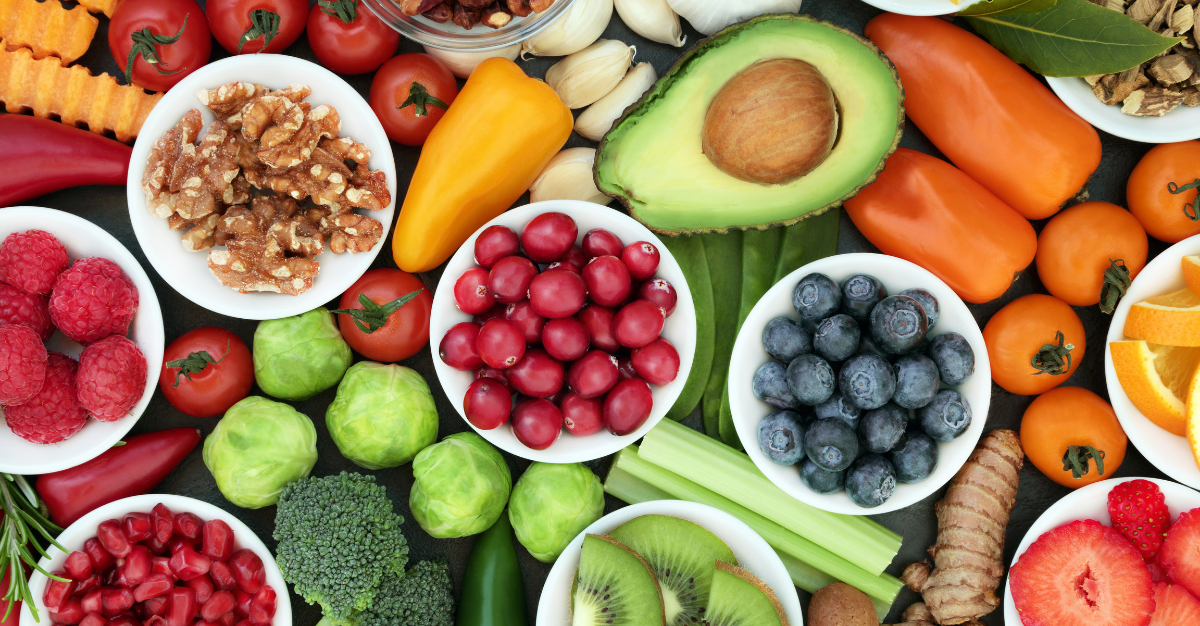
The small choices we make every day add up to a lasting impact on our long-term health. One of the most striking examples of how good decisions lead to good outcomes is the role of our everyday food choices on longevity. Growing research points to the importance of diet on both quality of life and lifespan – it turns out there really is a fountain of youth, and it starts with what you eat!
We Are What We Eat
Western diets have increasingly become pro-inflammatory, calorie heavy and nutrient devoid. In fact, the USDA Dietary Guidelines for Americans defines the Standard American Diet (SAD) as being too low in fresh fruits and vegetables, whole grains, lean protein, and healthy oils, and too high in red meat, high-fat dairy products, processed and fast foods, refined carbohydrates, added sugars, salt, and calories. Eating a Standard American Diet is a root cause of the “diseases of civilization.” Diseases of civilization include heart disease, diabetes, cancer, infertility, mental health issues, and other metabolic diseases – which all impact a long and healthy life.
The nutrients found in the right foods can alter the aging process at a cellular level, reducing damage from oxidative stress. In other words, the superfoods below can actually impact the aging process! We need to prioritize the foods that give our bodies the energy and strength that it needs in order to fight off disease and other effects of aging.
The Blue Zones: Models for Healthy Aging
Scientists have studied the diets and lifestyle of people living in the “blue zones,” which are areas with exceptionally long average lifespans, including Sardinia, Italy; Okinawa, Japan; and Ikaria, Greece. People in these areas share many common healthy lifestyle practices, like maintaining strong social connections and regular movement. They also share many dietary patterns, such as a focus on whole, natural and plant-based foods, and they avoid processed foods. The foods below appear often in research around the blue zones, and other studies show striking health benefits.
Top 10 Anti-Aging Superfoods
Let’s take a look at what studies today suggest are some of the top superfoods for longevity.
1 – Cruciferous vegetables
These flavorful veggies are high in fiber, antioxidants, and vitamins C, A, E, and K. Antioxidants help fight aging by curtailing damage from free radicals and reducing inflammation. Vitamin C is an antioxidant that can also help you look younger, since it boosts collagen production, which in turn strengthens your skin’s elasticity.
Cruciferous vegetables include broccoli, cauliflower, brussel sprouts, cabbage, turnips, and even radishes. Try stir frying some with some amino acids for flavor! Many are also good roasted – if you’ve never tried roasted radish before, it’s a great way to remove the bitter edge that characterizes raw radishes!
2 – Leafy green veggies
Leafy green vegetables are high in antioxidants, vitamin K, folate, fiber, and lutein, a nutrient that can help protect aging eyes. Studies have shown a diet with a lot of leafy greens helps protect against cognitive decline and heart disease. (Note that people who have to take anticoagulants should talk to their healthcare professional about eating foods high in vitamin K.)
Aim for a variety of leafy greens, and think outside the salad bowl: sauteed turnip greens, and baked kale chips are a nice change of pace. Generally speaking, aim for darker colors – spinach over iceberg lettuce in a salad, for example.
3 – Nuts and seeds
Don’t avoid nuts for fear of their calorie content. One study found that people with a diet high in nuts were 20% more likely to have a longer lifespan than those who didn’t consume them. Another found that people following a Mediterranean diet had improved cholesterol levels with increased nut intake. Walnuts, pistachios, and almonds are all particularly beneficial, and versatile. Add some salads and baking, or just snack! Nuts are a good source of fiber, antioxidants, and healthy fats.
Flax seeds, chia seeds, and hemp seeds are excellent sources of protein and omega-3, and have been linked to reduced cholesterol levels and lower blood pressure. It’s easy to incorporate these powerhouses into your diet – just sprinkle some on your cereal and even yogurt, and incorporate seeds into salads and wherever possible.
4 – Berries
Brightly colored berries like blueberries, strawberries, and raspberries are high in antioxidants, fiber, and vitamin C. Blueberries and strawberries can help fight insulin resistance and diabetes, and all berries are excellent substitutes for sweet desserts. Make sure to buy organic – all berries, strawberries in particular, can contain high levels of pesticides. Plus, organic tastes better!
5 – Beans and legumes
With their high amounts of fiber, beans keep your digestive system working in top shape and can help prevent colon and other digestive cancers. They’re also protective of heart health, and are associated with lower blood pressure. And, beans are a filling high protein source, which can help regulate blood sugar, and keep weight in check. In fact, one study linked bean consumption with a smaller waist circumference.
Beans are an excellent addition to soups, salads and stews. If you’re a meat eater, try adding some to recipes with ground beef, like meatballs, to add extra fiber and vitamins.
6 – Mushrooms
Mushrooms are high in B vitamins and potassium, and therefore good for your heart. They’re a good source of selenium, a mineral that acts as a powerful antioxidant.
They’re also very versatile, and can be enjoyed raw, grilled, or sauteed. Try marinating mushrooms on a skewer before barbecuing, or use a marinated portobello mushroom as a healthy burger substitute.
Recently, functional mushrooms have been taking center stage in the mainstream health and wellness space. Functional mushrooms include chaga, lion’s mane and cordyceps among others and are considered adaptogens for their supportive role in the body’s natural adaptation. Typically found in supplement form, functional mushrooms can be a great addition to your routine to help manage stress, improve focus and more. Be sure to speak with a qualified healthcare practitioner to see if these are right for you!
7 – Alliums like onions and garlic
These aren’t just flavor enhancers. Allium vegetables include onions, garlic, leeks, and shallots. Alliums have antioxidant, antibacterial, and anti-inflammatory properties, which are good for heart health and cancer prevention. Research suggests onions can even improve bone health. Some people have unpleasant digestive issues with onions, so some trial and error may be necessary, but it’s easy to add more sauteed or raw onions to many dishes.
8 – Tomatoes
In addition to high levels of insoluble fiber, vitamin C, and potassium, tomatoes are an excellent source of the antioxidant lycopene, which is associated with a lower risk of heart attacks and strokes. It’s also thought to lower rates of cancer and cholesterol levels. Lycopene content in tomatoes increases with cooking, so tomato sauces are particularly good sources.
9 – Turmeric
The medicinal properties of this herb have been recognized for centuries, and recent studies back its effectiveness. The benefits of turmeric are largely derived from the compound curcumin, which is highly anti-inflammatory and beneficial to heart health. Some studies have found that it can help prevent cancer and reduce the symptoms of arthritis. It’s difficult to get therapeutic levels through diet alone (although it is delicious in a smoothie), so supplements may help. Interestingly, absorption is increased when consumed with black pepper – a combination that happens in many spicy dishes.
10 – Green tea
The many benefits of green tea make it one of the healthiest beverages you can consume. It’s high in antioxidants and polyphenols, which are compounds associated with cancer prevention. Matcha green tea is considered one of the healthiest varieties of green tea because the entire leaf is consumed by tea drinkers. Make sure you are buying organic to reduce pesticide exposure and to ensure you are reaping all the benefits of this superfood
Eat Your Way To A Longer, Healthier Life
You may have noticed that all of these superfoods are easily adapted into your regular diet. These simple dietary changes can have positive impacts on your health, and, ultimately, your longevity.
Reach out if you want to learn more about lifestyle changes that can improve your quality of life!
Sources:
Matheson EM, Mainous AG 3rd, Carnemolla MA. The association between onion consumption and bone density in perimenopausal and postmenopausal non-Hispanic white women 50 years and older. Menopause. 2009 Jul-Aug;16(4):756-9. doi: 10.1097/gme.0b013e31819581a5. PMID: 19240657.
Caprara, Greta. ‘Diet and Longevity: The Effects of Traditional Eating Habits on Human Lifespan Extension’. 1 Jan. 2018 : 261 – 294.
Poulain, Michel, et al. “The Blue Zones: Areas of Exceptional Longevity around the World.” Vienna Yearbook of Population Research, vol. 11, Austrian Academy of Sciences Press, 2013, pp. 87–108, http://www.jstor.org/stable/43050798.
Morris MC, Wang Y, Barnes LL, Bennett DA, Dawson-Hughes B, Booth SL. Nutrients and bioactives in green leafy vegetables and cognitive decline: Prospective study. Neurology. 2018 Jan 16;90(3):e214-e222. doi: 10.1212/WNL.0000000000004815. Epub 2017 Dec 20. PMID: 29263222; PMCID: PMC5772164.
Morris MC, Wang Y, Barnes LL, Bennett DA, Dawson-Hughes B, Booth SL. Nutrients and bioactives in green leafy vegetables and cognitive decline: Prospective study. Neurology. 2018 Jan 16;90(3):e214-e222. doi: 10.1212/WNL.0000000000004815. Epub 2017 Dec 20. PMID: 29263222; PMCID: PMC5772164.
Pollock RL. The effect of green leafy and cruciferous vegetable intake on the incidence of cardiovascular disease: A meta-analysis. JRSM Cardiovasc Dis. 2016;5:2048004016661435. Published 2016 Aug 1. doi:10.1177/2048004016661435
Bansal M. Association of nut consumption with total and cause-specific mortality. Indian Heart J. 2014;66(3):388-389. doi:10.1016/j.ihj.2014.03.020
Damasceno NR, Sala-Vila A, Cofán M, Pérez-Heras AM, Fitó M, Ruiz-Gutiérrez V, Martínez-González MÁ, Corella D, Arós F, Estruch R, Ros E. Mediterranean diet supplemented with nuts reduces waist circumference and shifts lipoprotein subfractions to a less atherogenic pattern in subjects at high cardiovascular risk. Atherosclerosis. 2013 Oct;230(2):347-53. doi: 10.1016/j.atherosclerosis.2013.08.014. Epub 2013 Aug 21. PMID: 24075767.
Papanikolaou Y, Fulgoni VL 3rd. Bean consumption is associated with greater nutrient intake, reduced systolic blood pressure, lower body weight, and a smaller waist circumference in adults: results from the National Health and Nutrition Examination Survey 1999-2002. J Am Coll Nutr. 2008 Oct;27(5):569-76. doi: 10.1080/07315724.2008.10719740. PMID: 18845707.
Karppi J, Laukkanen JA, Sivenius J, Ronkainen K, Kurl S. Serum lycopene decreases the risk of stroke in men: a population-based follow-up study. Neurology. 2012 Oct 9;79(15):1540-7. doi: 10.1212/WNL.0b013e31826e26a6. PMID: 23045517.
Shoba G, Joy D, Joseph T, Majeed M, Rajendran R, Srinivas PS. Influence of piperine on the pharmacokinetics of curcumin in animals and human volunteers. Planta Med. 1998 May;64(4):353-6. doi: 10.1055/s-2006-957450. PMID: 9619120.
Matheson EM, Mainous AG 3rd, Carnemolla MA. The association between onion consumption and bone density in perimenopausal and postmenopausal non-Hispanic white women 50 years and older. Menopause. 2009 Jul-Aug;16(4):756-9. doi: 10.1097/gme.0b013e31819581a5. PMID: 19240657
Giordano A, Tommonaro G. Curcumin and Cancer. Nutrients. 2019;11(10):2376. Published 2019 Oct 5. doi:10.3390/nu11102376
Chandran B, Goel A. A randomized, pilot study to assess the efficacy and safety of curcumin in patients with active rheumatoid arthritis. Phytother Res. 2012 Nov;26(11):1719-25. doi: 10.1002/ptr.4639. Epub 2012 Mar 9. PMID: 22407780.
Kuriyama S, Shimazu T, Ohmori K, Kikuchi N, Nakaya N, Nishino Y, Tsubono Y, Tsuji I. Green tea consumption and mortality due to cardiovascular disease, cancer, and all causes in Japan: the Ohsaki study. JAMA. 2006 Sep 13;296(10):1255-65. doi: 10.1001/jama.296.10.1255. PMID: 16968850.

